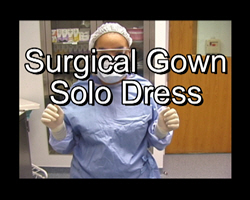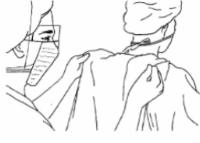|
Section V: Surgical Gown Technique
The specialist is to abide by the following principles whenever he dons a sterile gown:
a. If the specialist touches the outside of his gown while donning it, the gown is contaminated. If this occurs, discard the gown. The specialist is to touch only the inside of the gown while putting it on.
NOTE: Surgical gowns are folded with the inside facing the specialist. This method of folding facilitates picking up and donning the gown without touching the outside surface.
b. The specialist's scrubbed hands and arms are contaminated if he allows them to fall below waist level or to touch his body. The specialist, therefore, keeps his hands and arms above his waist and away from his body and at an angle of about 20 to 30 degrees above the elbows.
c. After donning the surgical gown, the only parts of the gown that are considered sterile are the sleeves (except for the axillary area) and the front from waist level to a few inches below the neck opening. If the gown is touched or brushed by an unsterile object, the gown is then considered contaminated. The contaminated gown is removed using the proper technique. You must then don a new sterile gown.
1-18. PROCEDURE--CLOSED CUFF METHOD
| a. With one hand, pick up the entire folded gown from the wrapper by grasping the gown through all layers, being careful to touch only the inside top layer, which is exposed (see Figure 1-15). Step back from the table to allow other team members room to maneuver. |
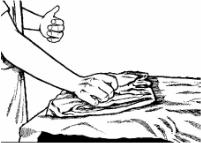 Figure 1-15 |
| b. Hold the gown in the manner shown in Figure 1-16, near the gown's neck, and allow it to unfold, being careful that it does not touch either your body or other unsterile objects.
c. Grasp the inside shoulder seams and open the gown with the armholes facing you.
|
 Figure 1-16 |
| d. Slide your arms part way into the sleeves of the gown, keeping your hands at shoulder level away from the body (see Figure 1-17). |
 Figure 1-17 |
| e. With the assistance of your circulator, slide your arms further into the gown sleeves; when your fingertips are even with the proximal edge of the cuff, grasp the inside seam at the juncture of gown sleeve and cuff using your thumb and index finger. Be careful that no part of your hand protrudes from the sleeve cuff (see Figure 1-18). |
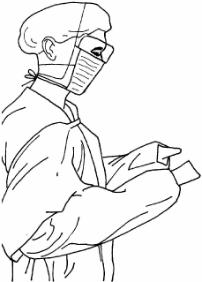 Figure 1-18 |
f. The circulator must continue to assist at this point. He positions the gown over your shoulders (see Figure 1-19) by grasping the inside surface of the gown at the shoulder seams.
|
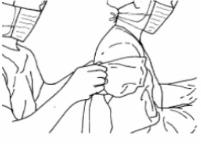 Figure 1-19.1 |
| NOTE: For the reusable cloth gown (which is rarely used), use the procedures given in steps a through f. The circulator then prepares to tie the gown. The neck and back ties are tied in an up-and-down motion. He then ties the belt by grasping the gown at the back as the scrub leans forward. The circulator leans down and grasps the distal end of one belt tie; this enables the circulator to handle the belt without touching any part of the gown that should remain sterile. The circulator then brings the belt tie to the back of the gown. The scrub then swings toward the opposite side so that the circulator can grasp the other belt in the same manner. The circulator will then tie the belt in an up-and-down motion; this reduces the area of contamination on the gown. The circulator will then tuck the ends of the belt inside the gown at the back. Then the scrub; proceeds to the gloving procedure. | |
| g. The circulator then prepares to secure the gown. The neck and back may be secured with a Velcro® tab or ties (see Figure 1-20). The circulator then ties the gown at waist level at the back. This technique prevents the contaminated surfaces at the back of the gown from coming into contact with the front of the gown. |
 Figure 1-20 |
1-19. PROCEDURE--OPEN CUFF METHOD
The procedure is the same as that for the closed cuff method with the exception of the steps described in paragraph 1-18e and in Figures 1-18 and 1-19.
a. Do not grasp the inside seam of the sleeve as described in paragraph 118e and shown in Figure 1-19. Allow your hands to protrude from the cuffs of the gown.
b.The circulator reaches inside the gown sleeves at the shoulder seams and pulls the gown over your shoulders and the cuffs over your hands instead of performing this step of the procedure as described in paragraph 1-18f and Figure 1-19. Both you and the circulator must be careful that the gown cuffs are not pulled too high on the wrists. The edge of the cuff should be at the distal end of the wrist.
NOTE: The scrub will proceed to the Glove Technique before completing final tie of gown.
|
|||||||||
|
LESSON OBJECTIVES After completing this lesson, you should be able to: 1-1. Select safe, effective procedures and techniques for performing a surgical scrub and donning sterile gown and gloves. 1-2. Assist other members of the "sterile" team in donning gown and gloves. 1-3. Select appropriate procedures for removing gown and gloves between cases. |
|||||||||
|
|||||||||
|
The Brookside Associates Medical Education Division is dedicated to the development and dissemination of medical information that may be useful to medical professionals and those in training to become medical professionals. This website is privately-held and not connected to any governmental agency. The views expressed here are those of the authors, and unless otherwise noted, do not necessarily reflect the views of the Brookside Associates, Ltd., any governmental or private organizations. All writings, discussions, and publications on this website are unclassified.
© 2008 Medical Education Division, Brookside Associates, Ltd. All rights reserved
